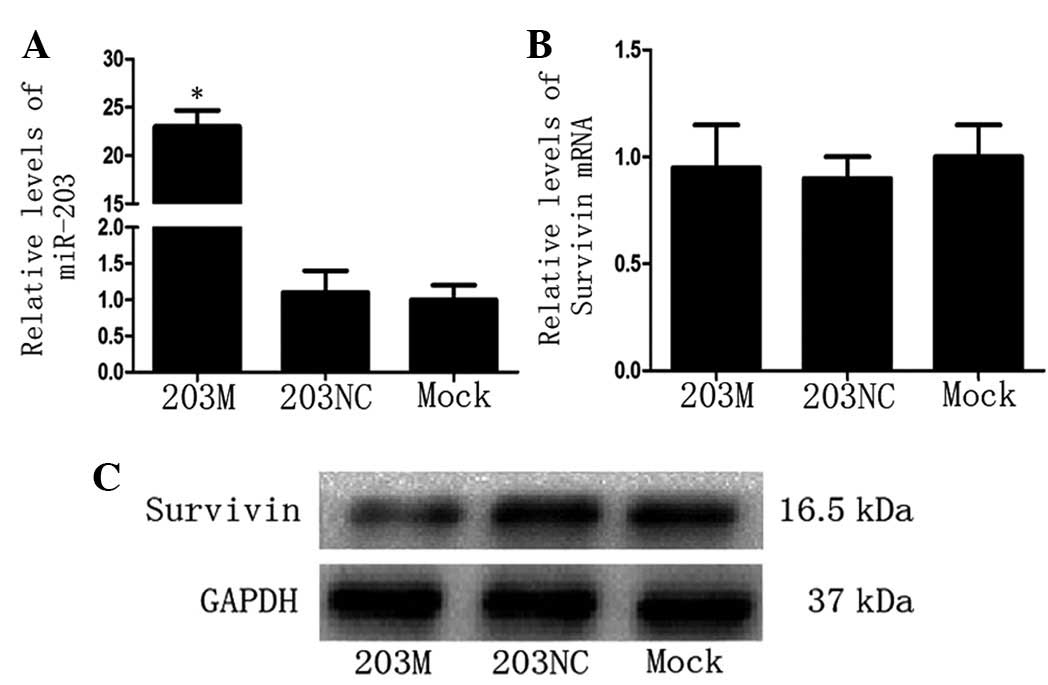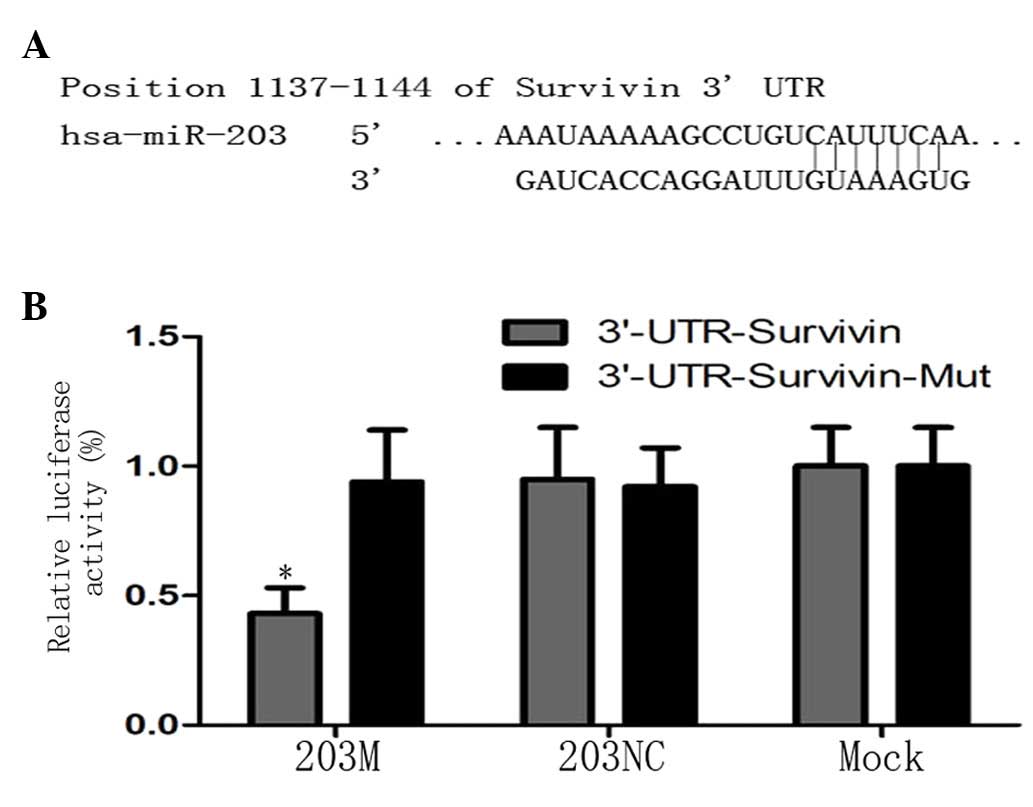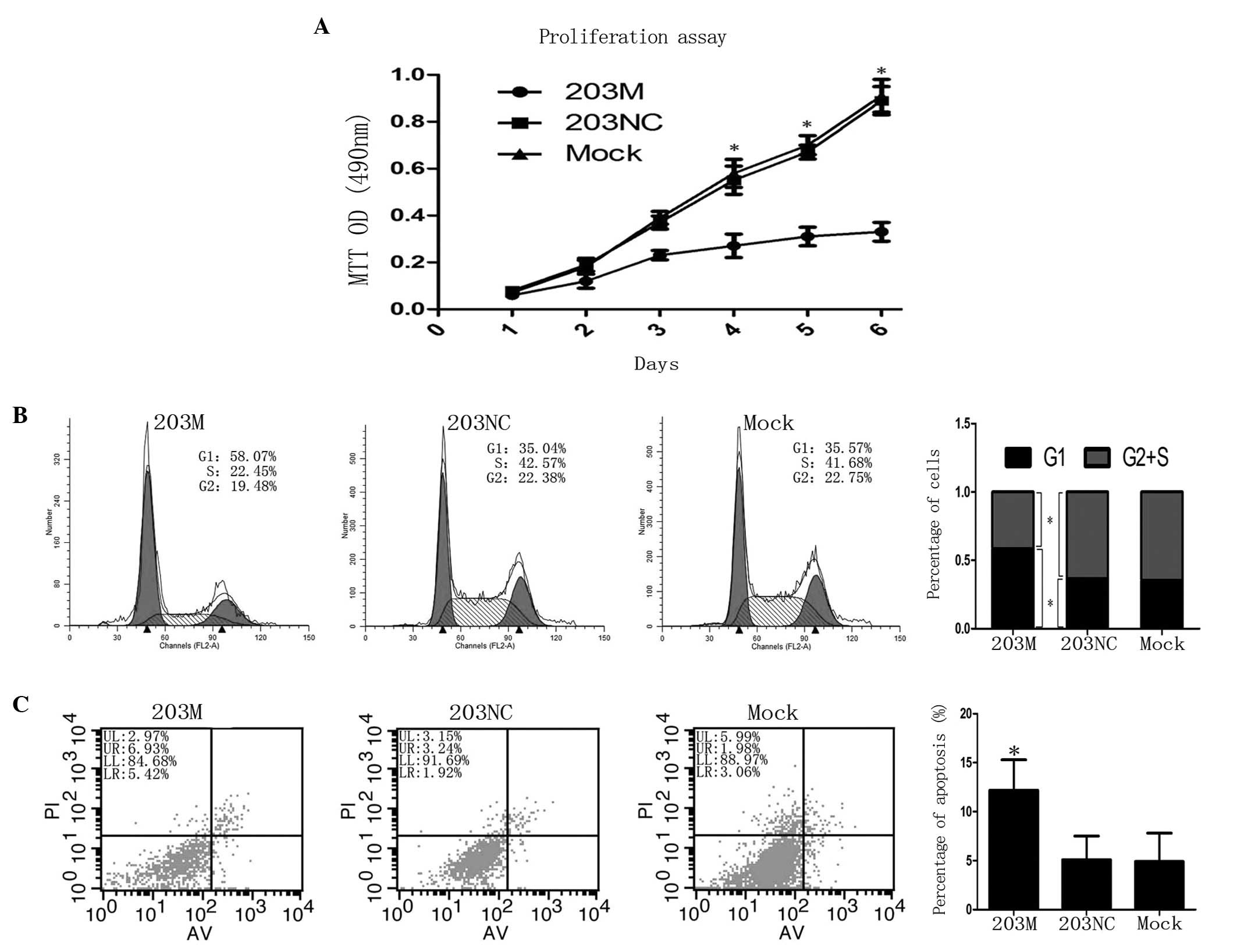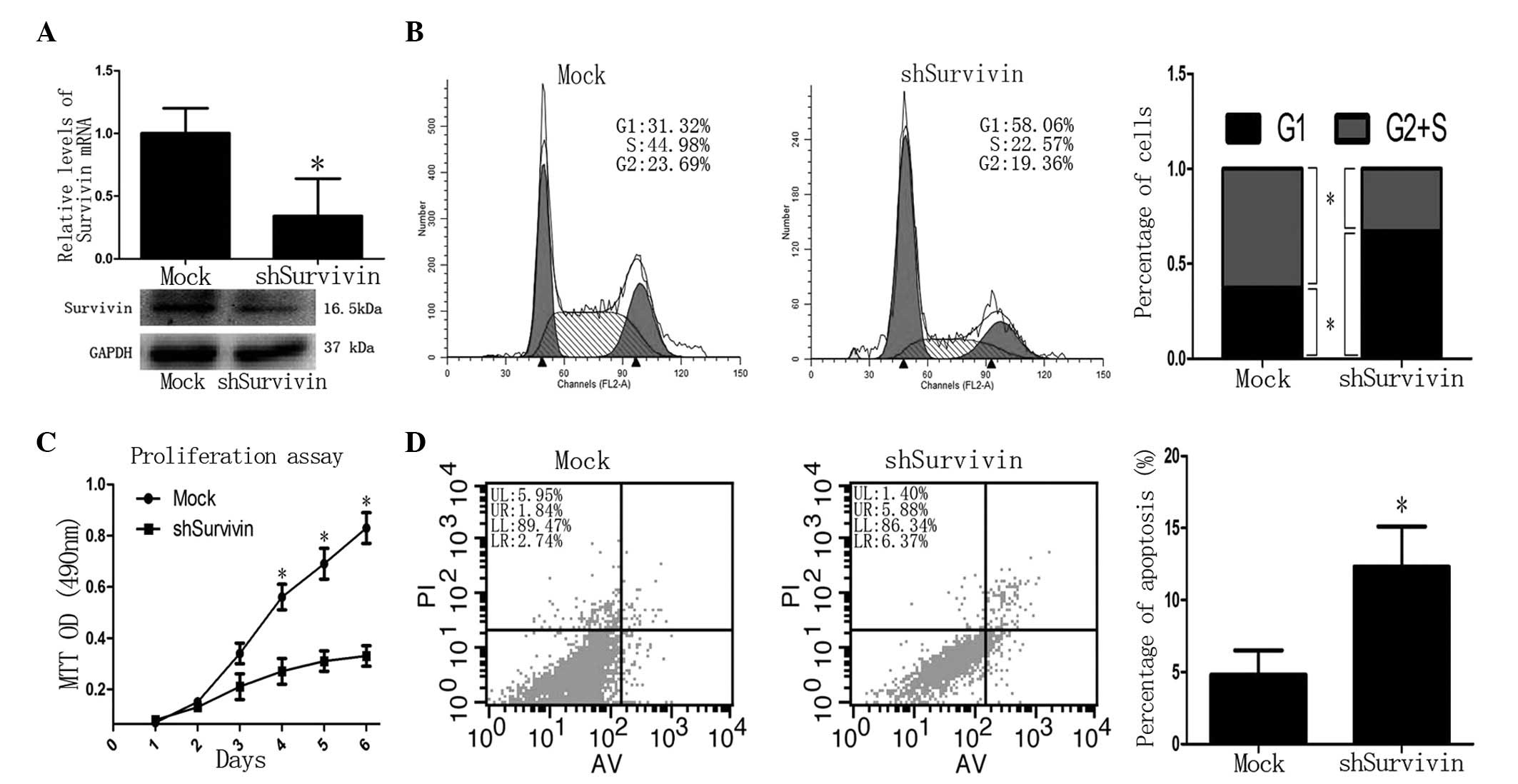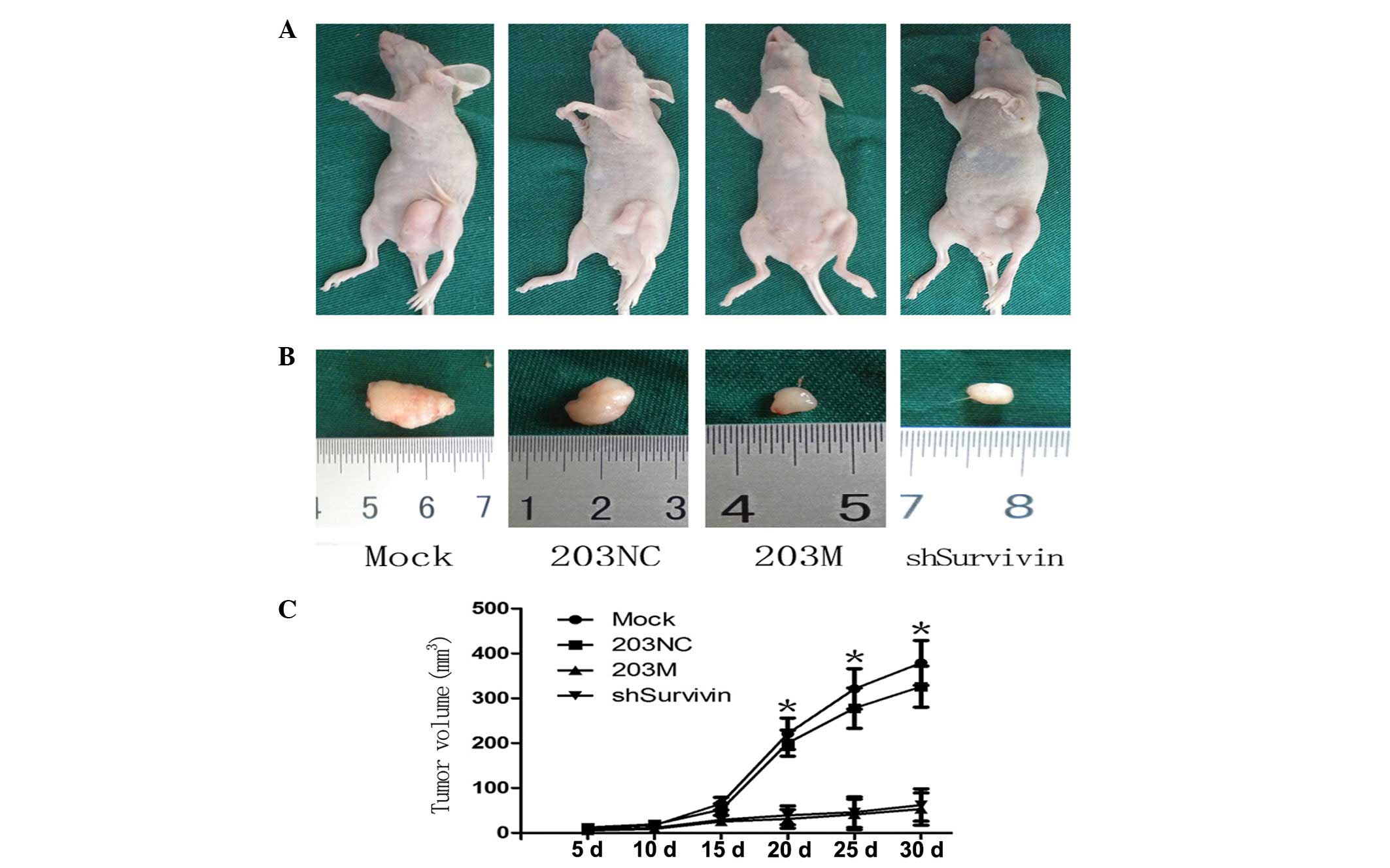miR‑203 regulates the proliferation, apoptosis and cell cycle progression of pancreatic cancer cells by targeting Survivin
- Authors:
- Published online on: May 31, 2013 https://doi.org/10.3892/mmr.2013.1504
- Pages: 379-384
Abstract
Introduction
Pancreatic cancer (PC) is a highly metastatic malignancy. Despite advanced developments in surgery, radiation therapy and chemotherapy for the treatment of PC, the 5-year survival rate following surgery in PC patients remains extremely poor (15–20%) (1). Therefore, it is urgent to identify new therapeutic targets or early diagnosis markers for PC.
Survivin (BIRC5) is a member of the inhibitors of apoptosis protein (IAP) family, which includes seven other members, as follows: X-linked inhibitor of apoptosis, cIAP1, cIAP2, NAIP, livin, IAP-like protein 2 and BRUCE (2). Survivin functions to regulate cell division, apoptosis, cellular stress responses and surveillance checkpoints, and its expression is abnormally high in a number of human malignancies, including esophageal, stomach, liver, brain, lung, breast, ovary and hematological cancer (3–5). The overexpression of Survivin is associated with advanced disease, resistance to therapy, reduced survival and induced recurrence (6). By contrast, the downregulation of Survivin may reduce cell proliferation and increase sensitivity to radiotherapy and cytotoxic drugs in various cancer cell lines, including head, neck, thyroid, lung, bladder, cervical and renal cancer (7–11). These observations indicate that Survivin may represent a molecular target for human cancer therapy.
MicroRNAs are a novel class of endogenous single-stranded and non-coding RNA molecules. They are 19–24 nucleotides long and function as gene expression regulators by targeting the 3′-untranslated region (UTR) of mRNA for degradation or translational repression (12). microRNAs have been identified to regulate cell proliferation, apoptosis, migration, invasion and the cell cycle in various cancer cell lines (13). In addition, it was previously reported that the elevated expression of miR-203 is associated with poor survival and may be used as a new prognostic marker for PC (14,15). Notably, while miR-203 is downregulated in hematopoietic malignancies and prostate cancer, it is upregulated in ovarian, bladder and colon cancer (16–20). These studies indicate that the role of miR-203 in tumorigenesis is complex. More recent studies have reported that miR-203 inhibits the proliferation of hepatocellular carcinoma (HCC) and laryngeal cancer cells by targeting Survivin (21,22).
In the present study, PC cell lines were used as an experimental model to investigate the expression and role of miR-203 in PC. In addition, we explored the relationship between miR-203 and Survivin expression and function, and aimed to determine whether miR-203 directly targets Survivin in PC cells to inhibit cancer progression.
Materials and methods
Cell culture
The human PC cell lines, SW1990, CFPAC-1, Panc-1 and BxPc-3, were obtained from Shanghai Cell Bank (Shanghai, China) and cultured in Dulbecco’s modified Eagle’s medium (DMEM) supplemented with 10% fetal bovine serum (FBS; both Wisent Inc., St-Bruno, QC, Canada), 100 μg/ml streptomycin, 100 μg/ml penicillin and 2 mM glutamine in a humidified chamber at 37°C with 5% CO2.
miRNA and siRNA transfection
miRNA and Survivin shRNA virus (shSurvivin) were designed and synthesized by Genepharma (Shanghai, China). CFPAC-1 cells were seeded in 6-cm tissue culture plates at a density of 50%. After 24 h, the cells were transfected with miRNAs or shSurvivin virus using reduced serum medium (OPTI-MEM-I) according to the manufacturer’s instructions. At 48 h post-transfection, the fluorescent index of the cells reached 90%.
qPCR
Total RNA was extracted from the cells using TRIzol reagent (Invitrogen Life Technologies, Carlsbad, CA, USA), and Primescript RT reagent (Takara Bio, Inc., Shiga, Japan) was used to synthesize cDNA. qPCR was performed with a 7500 Real-Time-PCR System (Applied Biosystems, Foster City, CA, USA) using the following primers: miR-203 forward, 5′-GTCGTTACCAGTGCAGGGTCCGAGG TATTCGCACTGGATACGACCTAGT-3′ and reverse, 5′-GCCCGTGAAATGTTTAGGACCAC-3′; U6 forward, 5′-ATTGGAACGATACAGAGAAGATT-3′ and reverse, 5′-GGAACGCTTCACGAATTTG-3′; Survivin forward, 5′-AGGACCACCGCATCTCTACATTC-3′ and reverse, 5′-CCTTGAAGCAGAAGAAACACTGGG-3′; and GAPDH forward, 5′-TCACCCACACTGTGCCCATCTACGA-3′ and reverse, 5′-CAGCGGAACCGCTCATTGCCAATGG-3′. GAPDH mRNA and U6 were used as internal controls for determining the relative expression levels of Survivin mRNA and miR-203, respectively. The comparative ΔΔCt method was used to calculate the relative expression levels of mRNA and miRNA, and the fold-changes were analyzed by 2−ΔΔCt.
Western blot analysis
Total protein was extracted from the cells using RIPA buffer containing 1% phenylmethylsulfonyl fluoride (PMSF) and the protein concentration was estimated with a BCA kit (Nanjing KeyGen Biotech. Co., Ltd., Nanjing, China). Protein was resolved by 12% sodium dodecyl sulfate polyacrylamide gel electrophoresis and transferred to polyvinylidene difluoride membranes. The membranes were blocked in Tris-buffered saline with 5% non-fat dry milk at 4°C for 12 h and subsequently incubated with rabbit polyclonal anti-Survivin antibody (Abcam, Cambridge, MA, USA) or mouse monoclonal anti-GAPDH antibody (Beyotime, Jiangsu, China) at 4°C for 12 h, followed by incubation with horseradish peroxidase-conjugated goat anti-rabbit or goat anti-mouse secondary antibody (Beyotime, Jiangsu, China) for 2 h at room temperature. Membranes were developed using an ECL kit (Pierce Biotechnology, Inc., Rockford, IL, USA) and exposed onto X-ray films to visualize the images. GAPDH served as a loading control.
Dual luciferase reporter assay
Four oligos corresponding to the 3′UTR of Survivin were synthesized as follows: wild type, 5′-CTAGATAAAAAGCCTGTCATTTCAAACACTGC TGTGGACGGCCGG-3′ and 5′-CCGTCCACAGCA GTGTTTGAAATGACAGGCTTTTTAT-3′; and mutant, 5′-CTAGATAAAAAGCCTGTCGCACCA AACACTGCTGTGGACGGCCGG-3′ and 5′-CCGTCCA CAGCAGTGTTTGGTGCGACAGGCTTTTTAT-3. The oligos were cloned into the XbaI site of the pGL3 luciferase reporter gene (Promega Corporation, Madison, WI, USA) to generate pGL3-Survivin-3′UTR and pGL3-Survivin-3′UTR-mut vectors. CFPAC-1 cells were cultured in 24-well tissue culture plates and co-transfected with 200 ng pGL3-Survivin or pGL3-Survivin-mut and 20 ng pRL-SV40 (Promega Corporation) containing Renilla luciferase and 20 pmol 203M or 203NC. At 48 h post-transfection, cells were collected and a Dual-Luciferase Reporter assay kit (Promega Corporation) was used to detect luciferase activity according to the manufacturer’s instructions. All experiments were performed in triplicate.
Cell proliferation, apoptosis and cell cycle analysis
An MTT kit (Nanjing KeyGen Biotech. Co., Ltd.) was used to determine cell proliferation. The cells were seeded in 96-well tissue culture plates (Costar; Corning Inc., Acton, MA, USA) at a density of 2×103 cells/well 24 h prior to transfection with miRNA or siRNA, and then replaced with 10% FBS-DMEM 6 h post-transfection and incubated for 48 h. MTT assays were performed daily for 6 days as described previously (23). Cell cycle and apoptosis were detected by flow cytometry (BD Biosciences, Franklin Lakes, NJ, USA) as described previously (23). All experiments were performed in triplicate.
Xenografts
A total of 16 four-week-old female nude BALB/cA-nu (nu/nu) mice were obtained from the Shanghai Experimental Animal Center (Chinese Academy of Sciences, Shanghai, China) and randomly divided into four groups. CFPAC-1, CFPAC-1-203NC, CFPAC-1-203M and CFPAC-1-shSurvivin cells were administered via a unilateral subcutaneous injection into the flanks of the mice (106 cells/100 μl/flank). Tumors were measured using vernier calipers every 5 days and the tumor volume was calculated using the following formula: (width2 × length)/2. The mice were then sacrificed after 30 days.
Statistical analysis
All data are presented as the mean ± SD. A Student’s t-test was used to analyze the differences between groups. Statistical analysis was performed with SPSS software (version 16.0; SPSS, Inc., Chicago, IL, USA). P<0.05 was considered to indicate a statistically significant difference.
Results
hsa-miR-203 inhibits Survivin protein expression in PC cells
Firstly, hsa-miR-203 and Survivin levels were examined in four PC cell lines. qPCR revealed that miR-203 expression levels were highest in BxPc-3 cells and lowest in CFPAC-1 cells (Fig. 1A). Western blot analysis revealed that Survivin protein levels were highest in CFPAC-1 cells and lowest in BxPc-3 cells (Fig. 1B). These results indicate that Survivin protein and hsa-miR-203 levels are negatively correlated in PC cells.
Since Survivin protein levels were high in CFPAC-1 cells, the 203M miRNA virus (miR-203 mimic) was transfected into CFPAC-1 cells and Survivin mRNA and protein levels were detected. As predicted, miR-203 levels increased significantly in the 203M group (P<0.05 vs. the 203NC group; Fig. 2A). Notably, compared with the control groups, there was no significant change in Survivin mRNA levels in the 203M group (Fig. 2B); however, Survivin protein levels decreased significantly in the 203M group (Fig. 2C). These results indicate that miR-203 inhibits Survivin expression post-transcriptionally.
Survivin is a direct target gene of miR-203 in PC cells
To confirm that Survivin is a direct target gene of miR-203 in PC cells, TargetScan (http://www.targetscan.org) was used to predict the 3′UTR of Survivin and the binding site of miR-203 (Fig. 3A). Based on this prediction, pGL3-Survivin-3′UTR and pGL3-Survivin-3′UTR-mut vectors were constructed as a luciferase reporter and control, respectively, and transfected into CFPAC-1 cells. The luciferase assay revealed that luciferase activity was decreased by ~51% in the 203M group compared with the controls (P<0.05; Fig. 3B). These results indicate that miR-203 directly targets Survivin via the binding site in its 3′UTR region.
hsa-miR-203 inhibits the proliferation and promotes the apoptosis of CFPAC-1 cells
To characterize the role of hsa-miR-203 in PC cells, hsa-miR-203 mimic 203M was transfected into CFPAC-1 cells. Cell proliferation was observed to be significantly inhibited after day 4 when compared with the control (P<0.05; Fig. 4A). Next, flow cytometry was employed to detect cell cycle progression and apoptosis. CFPAC-1 cells transfected with 203M revealed a reduced G2 + S phase compared with the control (41.6±5.7 vs. 64.7±5.9%, respectively; P<0.05), but exhibited increased G1 phase cell cycle arrest compared with the control (58.4±5.3 vs. 35.3±4.2%, respectively; P<0.05; Fig. 4B). In addition, the rate of apoptosis was higher in CFPAC-1 cells transfected with 203M than in the controls (12.2±2.1 vs. 5.1±1.3%, respectively; P<0.05; Fig. 4C). Taken together, these results indicate that miR-203 inhibits the proliferation of CFPAC-1 cells via the induction of G1 phase arrest and apoptosis.
Knockdown of Survivin inhibits the proliferation and promotes the apoptosis of CFPAC-1 cells
Next, the functional implication between miR-203 and Survivin was investigated in PC cells. Following knockdown of Survivin in CFPAC-1 cells by shRNA virus, Survivin mRNA and protein levels were decreased significantly compared with the controls (P<0.05; Fig. 5A). The MTT assay revealed that the proliferation of shSurvivin-transfected cells was decreased after 4 days (P<0.05 vs. control; Fig. 5C). Flow cytometric analysis revealed that the G2 + S phase was decreased in shSurvivin-transfected cells compared with the controls (37.3±4.6 vs. 67.2±4.8%, respectively; P<0.05) and the G1 phase was increased in shSurvivin-transfected cells compared with the control (62.7±5.3 vs. 32.8±3.9%, respectively; P<0.05; Fig. 5B). In addition, the rate of apoptosis in shSurvivin-transfected cells was higher than in the control (13.4±4.1 vs. 4.8±1.0%, respectively; P<0.05; Fig. 5D). These observations demonstrated that the loss of Survivin produces a similar phenotype as the gain of miR-203 in PC cells, indicating antagonism between Survivin and miR-203.
Downregulation of Survivin inhibits tumor growth in vivo
Finally, the functional antagonism between miR-203 and Survivin in PC was investigated in vivo. Following subcutaneous injection of transfected cells into the flanks of BALB/cA-nu nude mice, the resulting tumors were measured every 5 days for 30 days, followed by euthanasia of the mice. Tumor growth curves revealed that tumors of the shSurvivin group were significantly smaller than those of the control groups after 20 days (Fig. 6A). The tumor sizes in the 203M and shSurvivin groups were smaller than those in the control groups (Fig. 6B). The tumor growth curve demonstrated that tumor growth in the 203M and shSurvivin groups was slower than that in the control groups (Fig. 6C). These in vivo results are consistent with the in vitro results of this study and further confirm the antagonism between Survivin and miR-203 in PC growth.
Discussion
In recent years, the aberrant expression of miRNAs has been reported to be implicated in human malignancies (12,13). While miR-203 is downregulated in hematopoietic malignancies and prostate cancer, it is upregulated in ovarian, bladder and colon cancer (16–20). In the present study, miR-203 levels were found to negatively correlate with Survivin levels in PC cells. In addition, in vitro cell proliferation and apoptosis assays, as well as an in vivo xenograft model, demonstrated that miR-203 mimic inhibited the malignant phenotypes of CFPAC-1 cells. Notably, the knockdown of Survivin similarly inhibited the malignant phenotypes of CFPAC-1 cells. A luciferase assay further confirmed that miR-203 inhibited the expression of Survivin by directly targeting its 3′UTR. Survivin is known to promote cancer cell survival and drug resistance (6). It is reasonable to hypothesize that miR-203 suppresses the expression of Survivin, leading to its loss of oncogenic function. This prediction is consistent with the downreguation of miR-203 and overexpression of Survivin in PC and indicates that miR-203 is an anti-oncomir, at least in PC. These observations are also consistent with previous results in HCC and laryngeal cancer cells (21,22).
miR-203 was demonstrated to be overexpressed in pancreatic adenocarcinoma samples with advanced disease, and indicated a shorter survival time or poorer prognosis for patients who underwent pancreatectomy (14,15). The same outcome was demonstrated in colon cancer (20). These results indicate that miR-203 functions as an oncomir. By contrast, miR-203 has also been reported to directly target oncogenes, including ABL1, Bcl-w, Runx2, Scr, AKT2 and DNp63, functioning as a tumor-suppressor in esophageal, gastric, hepatocellular, bladder, prostate and colorectal cancer and hematological malignancies (16,23–27). Therefore, the function of miR-203 in different tissues is complex and further studies are required to understand its underlying mechanisms.
In conclusion, in the present study, miR-203 was demonstrated to inhibit the proliferation and induce the apoptosis of PC cells. In addition, Survivin was identified as a direct target of miR-203. These results indicate that miR-203 functions as an anti-oncomir in PC and represents a potential molecular target for PC therapy.
Acknowledgements
The present study was approved by the ethics committee of Nanjing Medical University, Nanjing, Jiangsu, PR China. (No. NJMU-ERLAUA-20120901). The authors thank Medjaden Bioscience Limited for assistance in the preparation of this manuscript.
References
|
Liu BB and Wang WH: Survivin and pancreatic cancer. World J Clin Oncol. 2:164–168. 2011. View Article : Google Scholar : PubMed/NCBI | |
|
Kelly RJ, Lopez-Chavez A, Citrin D, Janik JE and Morris JC: Impacting tumor cell-fate by targeting the inhibitor of apoptosis protein survivin. Mol Cancer. 10:352011. View Article : Google Scholar : PubMed/NCBI | |
|
Yamamoto H, Ngan CY and Monden M: Cancer cells survive with survivin. Cancer Sci. 99:1709–1714. 2008. View Article : Google Scholar : PubMed/NCBI | |
|
Pennati M, Folini M and Zaffaroni N: Targeting survivin in cancer therapy. Expert Opin Ther Targets. 12:463–476. 2008. View Article : Google Scholar | |
|
Fukuda S and Pelus LM: Survivin, a cancer target with an emerging role in normal adult tissues. Mol Cancer Ther. 5:1087–1098. 2006. View Article : Google Scholar : PubMed/NCBI | |
|
Cao C, Mu Y, Hallahan DE and Lu B: XIAP and survivin as therapeutic targets for radiation sensitization in preclinical models of lung cancer. Oncogene. 23:7047–7052. 2004. View Article : Google Scholar : PubMed/NCBI | |
|
Sharma H, Sen S, Lo Muzio L, Mariggiò A and Singh N: Antisense-mediated downregulation of anti-apoptotic proteins induces apoptosis and sensitizes head and neck squamous cell carcinoma cells to chemotherapy. Cancer Biol Ther. 4:720–727. 2005. View Article : Google Scholar : PubMed/NCBI | |
|
Du ZX, Zhang HY, Gao da X, Wang HQ, Li YJ and Liu GL: Antisurvivin oligonucleotides inhibit growth and induce apoptosis in human medullary thyroid carcinoma cells. Exp Mol Med. 38:230–240. 2006. View Article : Google Scholar : PubMed/NCBI | |
|
Fuessel S, Kueppers B, Ning S, Kotzsch M, Kraemer K, Schmidt U, Meye A and Wirth MP: Systematic in vitro evaluation of survivin directed antisense oligodeoxynucleotides in bladder cancer cells. J Urol. 171:2471–2476. 2004. View Article : Google Scholar : PubMed/NCBI | |
|
Zhang Y, Chen ZD, Du CJ, Xu G and Luo W: siRNA targeting survivin inhibits growth and induces apoptosis in human renal clear cell carcinoma 786-O cells. Pathol Res Pract. 205:823–827. 2009. View Article : Google Scholar : PubMed/NCBI | |
|
Li QX, Zhao J, Liu JY, Jia LT, Huang HY, Xu YM, Zhang Y, Zhang R, Wang CJ, Yao LB, Chen SY and Yang AG: Survivin stable knockdown by siRNA inhibits tumor cell growth and angiogenesis in breast and cervical cancers. Cancer Biol Ther. 5:860–866. 2006. View Article : Google Scholar : PubMed/NCBI | |
|
Hobert O: Gene regulation by transcription factors and microRNAs. Science. 319:1785–1786. 2008. View Article : Google Scholar : PubMed/NCBI | |
|
Esquela-Kerscher A and Slack FJ: Oncomirs - microRNAs with a role in cancer. Nat Rev Cancer. 6:259–269. 2006. View Article : Google Scholar | |
|
Greither T, Grochola LF, Udelnow A, Lautenschläger C, Würl P and Taubert H: Elevated expression of microRNAs 155, 203, 210 and 222 in pancreatic tumors is associated with poorer survival. Int J Cancer. 126:73–80. 2010. View Article : Google Scholar : PubMed/NCBI | |
|
Ikenaga N, Ohuchida K, Mizumoto K, Yu J, Kayashima T, Sakai H, Fujita H, Nakata K and Tanaka M: MicroRNA-203 expression as a new prognostic marker of pancreatic adenocarcinoma. Ann Surg Oncol. 17:3120–3128. 2010. View Article : Google Scholar : PubMed/NCBI | |
|
Bueno MJ, Pérez de Castro I, Gómez de Cedrón M, Santos J, Calin GA, Cigudosa JC, Croce CM, Fernández-Piqueras J and Malumbres M: Genetic and epigenetic silencing of microRNA-203 enhances ABL1 and BCR-ABL1 oncogene expression. Cancer Cell. 13:496–506. 2008. View Article : Google Scholar : PubMed/NCBI | |
|
Viticchiè G, Lena AM, Latina A, Formosa A, Gregersen LH, Lund AH, Bernardini S, Mauriello A, Miano R, Spagnoli LG, Knight RA, Candi E and Melino G: MiR-203 controls proliferation, migration and invasive potential of prostate cancer cell lines. Cell Cycle. 10:1121–1131. 2011.PubMed/NCBI | |
|
Iorio MV, Visone R, Di Leva G, Donati V, Petrocca F, Casalini P, Taccioli C, Volinia S, Liu CG, Alder H, Calin GA, Menard S and Croce CM: MicroRNA signatures in human ovarian cancer. Cancer Res. 67:8699–8707. 2007. View Article : Google Scholar : PubMed/NCBI | |
|
Gottardo F, Liu CG, Ferracin M, Calin GA, Fassan M, Bassi P, Sevignani C, Byrne D, Negrini M, Pagano F, Gomella LG, Croce CM and Baffa R: Micro-RNA profiling in kidney and bladder cancers. Urol Oncol. 25:387–392. 2007. View Article : Google Scholar : PubMed/NCBI | |
|
Schetter AJ, Leung SY, Sohn JJ, Zanetti KA, Bowman ED, Yanaihara N, Yuen ST, Chan TL, Kwong DL, Au GK, Liu CG, Calin GA, Croce CM and Harris CC: MicroRNA expression profiles associated with prognosis and therapeutic outcome in colon adenocarcinoma. JAMA. 299:425–436. 2008. View Article : Google Scholar : PubMed/NCBI | |
|
Wei W, Wanjun L, Hui S, Dongyue C, Xinjun Y and Jisheng Z: miR-203 inhibits proliferation of HCC cells by targeting survivin. Cell Biochem Funct. 31:82–85. 2013. View Article : Google Scholar : PubMed/NCBI | |
|
Bian K, Fan J, Zhang X, Yang XW, Zhu HY, Wang L, Sun JY, Meng YL, Cui PC, Cheng SY, Zhang J, Zhao J, Yang AG and Zhang R: MicroRNA-203 leads to G1 phase cell cycle arrest in laryngeal carcinoma cells by directly targeting survivin. FEBS Lett. 586:804–809. 2012. View Article : Google Scholar : PubMed/NCBI | |
|
Wang F, Xue X, Wei J, An Y, Yao J, Cai H, Wu J, Dai C, Qian Z, Xu Z and Miao Y: hsa-miR-520h downregulates ABCG2 in pancreatic cancer cells to inhibit migration, invasion, and side populations. Br J Cancer. 103:567–574. 2010. View Article : Google Scholar : PubMed/NCBI | |
|
Bo J, Yang G, Huo K, Jiang H, Zhang L, Liu D and Huang Y: microRNA-203 suppresses bladder cancer development by repressing bcl-w expression. FEBS J. 278:786–792. 2011. View Article : Google Scholar : PubMed/NCBI | |
|
Li J, Chen Y, Zhao J, Kong F and Zhang Y: miR-203 reverses chemoresistance in p53-mutated colon cancer cells through downregulation of Akt2 expression. Cancer Lett. 304:52–59. 2011. View Article : Google Scholar : PubMed/NCBI | |
|
Saini S, Arora S, Majid S, Shahryari V, Chen Y, Deng G, Yamamura S, Ueno K and Dahiya R: Curcumin modulates microRNA-203-mediated regulation of the Src-Akt axis in bladder cancer. Cancer Prev Res (Phila). 4:1698–1709. 2011. View Article : Google Scholar : PubMed/NCBI | |
|
Yuan Y, Zeng ZY, Liu XH, Gong DJ, Tao J, Cheng HZ and Huang SD: MicroRNA-203 inhibits cell proliferation by repressing ΔNp63 expression in human esophageal squamous cell carcinoma. BMC Cancer. 11:572011. |




